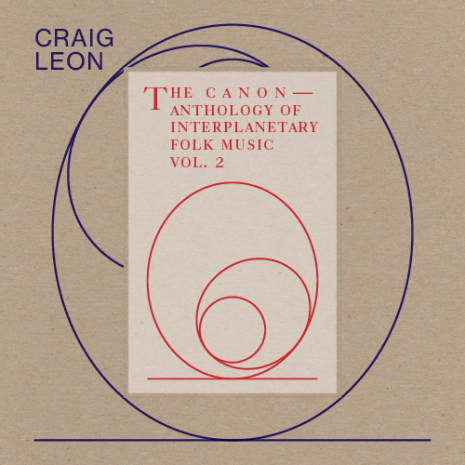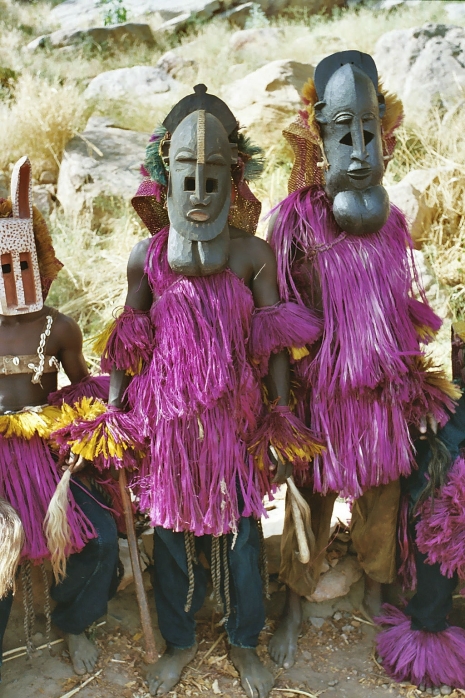
If you were to play the “Six Degrees of Kevin Bacon” parlor game with a musical figure, an interesting replacement for the well-connected actor might be record producer, performer and arranger Craig Leon. Leon’s long and storied career in the music business connects the Ramones to Luciano Pavarotti, Suicide to Sir James Galway, The Fall to The Royal Philharmonic Orchestra and The Go Betweens to Joshua Bell. He’s worked with Blondie, Bob Marley, The Bangles, The Chameleons, Jeffrey Lee Pierce and many (many) others.
Leon has also written and performed on several albums under his own name, notably the quirky conceptual cycle of his early 80s “Interplanetary Folk Music” work based on the highly advanced and very specific cosmology of the West African Dogon tribe. These days he is mostly working with large scale classical and symphonic projects, but in his new Anthology of Interplanetary Folk Music Vol. 2: The Canon, Leon’s returning to the cosmic lore of his earlier releases. It’s a fascinating album incorporating African tribal rhythms with electronic drones that rise out of the blackness of deep space. Think Remain in Light meets La Monte Young and that will at least get you in the right frame of mind to enjoy The Canon.
Craig Leon’s Anthology of Interplanetary Folk Music Vol. 2: The Canon will be available May 10, 2019 on LP, CD, and digital formats from RVNG Records. Following the US debut of their new live show at Moogfest last month, Leon and Cassell Webb—Craig’s wife and creative partner—will play “Ambient Church” at The First United Methodist Church in Pasadena, California on Friday, May 24 and at the upcoming Dancity Festival of underground culture and electronic music in Italy, along with a string quartet.
I asked Craig a few questions via email.
Richard Metzger: As someone with a similar interest myself—via Robert Anton Wilson’s Cosmic Trigger and Robert KG Temple’s The Sirius Mystery—how did your fascination with the cosmology of the Dogon people begin?
Craig Leon: Back in the mid 70s the Brooklyn Museum hosted a comprehensive collection of sculptures and other forms of visual art of the Dogon tribe of Mali whose religion is based in reveries and recollections of a visit from an extraterrestrial species they named the “Nommos.” Years after experiencing the exhibit, I remained fascinated by the idea of the alien visitors and the very precise information that the elders of the tribe related to the anthropologists who they encountered.
I was not so much intrigued by the actual music of the tribe, In fact I knew very little about it. It was something about their art.

Virtually all of the art of the Dogon people relates solely to their mythology, or religion or whatever you want to call it. They don’t think it’s a mythology, they think it’s real, so for them it is real. They have a theory that extraterrestrial beings from another planet, called “ Nommos” came and accomplished the same task that angels in our culture did (Catholic culture, Protestant culture or whatever). Apparently the “Nommos” came from the sky and taught them how to create the basic tools of civilization, construction of buildings, farming and so on.
The tribespeople were very specific about quite a bit regarding these beings. They knew how they looked, they knew how they functioned on the Earth, differently than the way people did, but more interesting, they had a very complicated philosophical system that they said this was taught to them by these other beings and was passed down from generation to generation orally.
This oral tradition becomes the roots of the Egyptian religion, which is very close by African standards to where the Dogon live, and it is indeed very similar,
Their story also describes where the Nommos came from. They said that they knew specifically where they came from and they described a double star planet system (Sirius) that revolves around itself, that has planet and that this one is a dead planet and that one is alive. It takes a number of Earth seasons for one to go around the other; and they knew that planets go around their Sun. That’s old stuff that’s not so modern, it was forgotten for a thousand years or so, but the ancients knew that.
So they were very specific and there is a star system that does that and it is in the place where the Dogon said the Nommos came from, so it’s kind of a good coincidence. I thought “Maybe they were correct, maybe this is true,” so I decided make a bit of a speculative fiction piece of music about not so much making the music of the Dogon, but what the music of the people from the other plane might be. What was the indigenous music of their planet?
What do you think really happened? I just take it—what the elders have passed down—at face value. For me there’s no other way to explain it.
Craig Leon: Well…there’s several ways you could look at this.
First you could be skeptical and say that the anthropologists conveyed all of this material to the tribesmen that they met. That’s a pretty far stretch. You’d be asking a group of illiterate remote people to memorize a very complex series of events and facts and then have them spout all of it back to you as their own ancient tradition. Why would they bother to do that? I don’t think they would be that accommodating even if they could assimilate all of that baggage. So.. in my mind that’s the most far-fetched possibility.
Secondly it could be that someone in the past history conveyed the entire Egyptian cosmogony to the Dogon of long ago and again they adapted it as their own plus adding a twist of their own astronomical observations to it. Perhaps that’s a bit less far-fetched but still pretty much a dubious idea.
Third - It could be that Robert Temple made it all up. Possible but there is too much evidence to the contrary that predates him.
Lastly it could have just happened the way the Dogon tell it.
My personal belief is that the answer lies somewhere close to the last idea with a bit of three and two possibly mixed in.
How did the first installment of this trilogy happen to come out on John Fahey’s Takoma label?
Craig Leon: John Fahey’s manager, Denny Bruce, was and still is a good friend of mine. He was running the Takoma label with John at the time as well as managing John, Leo Kottke, Jack Nitzsche and quite a few other artists. One day Denny mentioned to me that there was a slot open at the label for a synthesiser project and would I be interested in filling it.
At first this seems incongruous since most record collectors and fans associate Takoma with being the home of eclectic acoustic guitar driven Americana material. However Fahey was an early champion of and participant in the mid 20th century American avant garde composition scene. A number of his early projects utilized the techniques of musique concrète for instance. He also had released recordings of synthesiser pioneers on the label in the past. So it wasn’t all that strange.
After some initial loose conversations we went in for a more official meeting with John and Denny and various folks from the distributor to discuss the project. John was an avid fan of Harry Smith’s seminal Anthology of American Folk Music set. I told him about the proposed “Anthology of Interplanetary Folk Music” set that I wanted to do with the first piece being about the Dogon story. Much enthusiasm ensued and we were off to the races.
Originally I wanted the record to be orchestral with live drumming as well as synths but there wasn’t remotely enough of a budget to do that. So it became a purely electronic recording.
Why have you returned to the music of the Nommos again after so many years?
Craig Leon: The Canon returns to the concept espoused in Nommos but not necessarily the music. It speculates that humans heard the music of the Nommos and adapted it to their own creations. This is depicted in the second and third tracks of the album which are less like Nommos/Visiting in their rhythmic patterns and are intrinsically closer to “authentic” African rhythms.
From there my story progresses that a mythical traveller from the Dogon tribe makes their way from their homeland to Ancient Egypt carrying with them the knowledge and teachings of the Nommos (i.e. “The Canon”). This body of thought is transformed yet again. The music then follows a more and more clear path into the realm of inner thought and development that was fundamental to the religious and philosophical thought of the Dogon.
Do you reckon the Nommo’s synthesizers have improved much since the early 1980s?
Craig Leon: Tuning is arguably better and easier on newer models.
On Nommos I used many of the same synths that made Nommos/Visiting including the original pair of Roland Jupiter JP4s which I still have as well as an Arp 2600, a four oscillator Minimoog, Moog 55 modular and so on. However I also used digital processing of effects, Waveform Kurzweil synths and a neat digital computerised synth which emulates old analog programming to flesh out some of the sounds.
I’m not one to say “analog is better than digital” or vice versa. Whatever it takes to get this sound you hear in your head is what you should use.
How will you be promoting the album live?
Craig Leon: Cassell and I played bits of The Canon in live performances in Europe last year. We just played the bulk of it complete at Moogfest in North Carolina, U.S. and will be doing the same at Ambient Church concerts which start on 24 May in L.A. and go on shortly thereafter to NY. European dates follow through the summer.
We also have a version of Nommos/Visiting and The Canon which we has friends on acoustic instruments and drums as well as the synths. These gigs will follow on later. Hopefully one will be filmed in a very beautiful location and we’ll be able to share it.
How was Moogfest?
Craig Leon: It’s always nice to exchange ideas with old friends and colleagues and meet new ones.
I was particularly happy to have done a couple of panels there…one with my friend William Basinski and another with Jimmy Destri- my cohort for the old Blondie days. I heard a lot of interesting new music as well. Check out Kelly Moran for an American 20th century prepared piano meets the East updated thing and found musique concrete experimenter Bergsonist if you get a chance.
“Standing Crosswise in the Square”
“The Gates Made Plain”